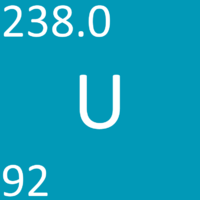Difference between revisions of "Uranium"
| Line 21: | Line 21: | ||
: [[Uranium]] is [[ductile]]. | : [[Uranium]] is [[ductile]]. | ||
==Key Stage 4== | ==Key Stage 4== | ||
| + | [[File:UKS4.PNG|right|200px|thumb|The [[Chemical Symbol|chemical symbol]] for [[Uranium]].]] | ||
===Meaning=== | ===Meaning=== | ||
[[Uranium]] is a [[Actinide]] [[metal]] [[element]], on the [[Periodic Table]], with 92 [[proton]]s in the [[Atomic Nucleus|nucleus]]. | [[Uranium]] is a [[Actinide]] [[metal]] [[element]], on the [[Periodic Table]], with 92 [[proton]]s in the [[Atomic Nucleus|nucleus]]. | ||
Latest revision as of 14:53, 5 March 2020
Contents
Key Stage 2
Meaning
Key Stage 3
Meaning
Uranium is a Actinide metal element, on the Periodic Table, with an atomic number of 92.
About Uranium
Molecular Structure
- Uranium has the chemical symbol U.
- Uranium atoms join together in large numbers to form a giant metal molecule.
Atomic Structure
- Uranium as 92 protons and 146 neutrons in its nucleus giving it an Atomic Number of 92 and an atomic mass of 238.
- Uranium is in Period 7 of the Periodic Table because it has 7 electron shells.
Properties
- Uranium is a metal element so it is a good thermal conductor and a good electrical conductor.
- Uranium is a shiny solid at room temperature.
- Uranium is malleable.
- Uranium is sonorous.
- Uranium is ductile.
Key Stage 4
Meaning
Uranium is a Actinide metal element, on the Periodic Table, with 92 protons in the nucleus.
About Uranium
Molecular Structure
- Uranium has the chemical formula U.
- Uranium atoms join together in a giant metallic structure.
Atomic Structure
- The most stable isotope of Uranium has 146 neutrons in its nucleus giving it an atomic mass of 238.
- Uranium is in Period 7 of the Periodic Table because it has 7 electron shells.
- Uranium loses electrons to form positive metal ions.
Properties
- Uranium forms ionic bonds with non-metals.
- Uranium is a metal element so it is a good thermal conductor and a good electrical conductor.
- Uranium is a shiny solid at standard temperature and pressure and has a high melting point.
- Uranium is malleable.
- Uranium is sonorous.
- Uranium is ductile.
References
AQA
- Uranium, pages 18, 21, 49, GCSE Physics; The Revision Guide, CGP, AQA
- Uranium, pages 276-7, GCSE Physics; Student Book, Collins, AQA
- Uranium, pages 37, 104-105, GCSE Physics; Third Edition, Oxford University Press, AQA
- Uranium, pages 45, 55, GCSE Combined Science Trilogy; Physics, CGP, AQA
- Uranium, pages 47, 57, 140, GCSE Physics; The Complete 9-1 Course for AQA, CGP, AQA
- Uranium-235, pages 128-9, GCSE Physics; Student Book, Collins, AQA

